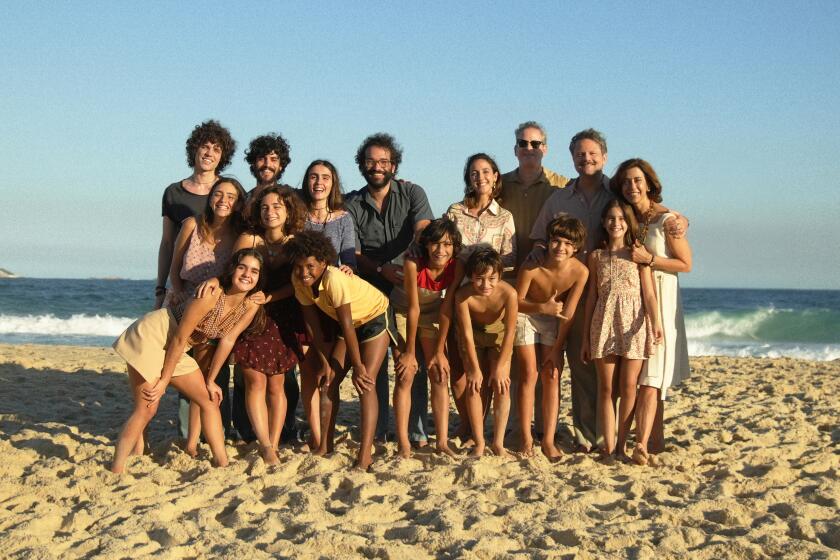A war story taken from family lore, ‘Vermiglio’ involves an entire village

- Share via
Inspiration comes in all forms. Sometimes it’s your imagination, sometimes it’s real-life experiences and, often, it’s a combination of both. Maura Delpero’s new drama “Vermiglio,” Italy’s shortlisted entry for the international film Oscar, was the latter. It came to her while she slept.
“My father visited me in a dream, but the specificity of this dream was interesting because I dreamed about him as a child, as a young boy, 6 years old,” Delpero recalls. “It was very similar to a photo I knew by him. Now, I think that it had to do with this passage of life in which I was turning into an adult. And you kind of begin to see your fathers and mothers, and you become the adult.”
Delpero’s vision began with her father playing with his nine siblings in their childhood home in Vermiglio, a picturesque village in the Italian Alps. Because of its high elevation and distance from larger towns, the village largely avoided the horrors of World War II. The film, however, depicts a period of great change for this family, this small community and Italy immediately after. The dream inspired a personal story that allowed her father to live with the filmmaker just a little while longer. Her extended family also became a treasure trove of memories to fashion into the film.
Director Walter Salles had ties to the political family in ‘I’m Still Here.’ Their story reveals the collective journey of a country.
“There was so much to fish because it was a big family, and big families hide a lot of stories and have so many temperaments and colors,” Delpero says. “And I absorbed this in my childhood. It’s a moment in which you absorb things in a very sensorial way because you don’t have all the filters we have [as adults]. So, in a way, it was like I had a lot of smells and tastes and sentences and faces and temperaments and destinies [to select from].”
While peppered with these multiple narrative threads, the main storyline centers on a romance between her grandfather’s oldest daughter, Lucia (Martina Scrinzi), and Pietro (Giuseppe De Domenico), an army deserter hiding in the village. With Lucia pregnant, the war ending and the pair seemingly in love, they quickly get married. When Lucia’s parents and the town elders insist Pietro return to Sicily to inform his own family that he’s safe, the once-idyllic romance soon transforms into an unforeseen tragedy.

“What I am allowed to say is that it’s a story from the valley, and there were a lot of stories like this,” Delpero notes. “It’s true. It happened in my family. But for a privacy thing, I usually say that it has to do with a story of the valley that the village [is part of].”
Whatever Pietro’s shocking fate, no matter how fundamentally he changed the course of her aunt’s life, the filmmaker believes the character, at least, deserves some compassion. She notes, “I don’t think he’s an a—. I think he’s a young boy who was taken from his family and thrown into a war. He’s not dead just because of luck. And he arrives in the village, he finds a girl and her name, Lucia, means light, and it’s light after darkness, and he falls in love because he’s young.”
For Delpero, Lucia’s story mirrors that of the women she chronicled in her 2012 documentary, “Nadea e Sveta,” about Moldavian women who move to Italy to send money back to children they will not see for months on end. At the end of “Vermiglio,” Lucia leaves not only the tranquility and simple life of her village but the supportive embrace of her sisters to go to the city for a better life for herself and her daughter.
The filmmaker knew he would likely be sentenced to prison again. So he fled to Europe in time for the Cannes premiere of ‘The Seed of the Sacred Fig,’ shot covertly in Iran.
“In this, she’s a very modern character and a very individual character, because when you begin the film, you have all the sisters together in the same bed, and then you end up with this empty bed. At the beginning, it’s really a community,” Delpero says. “You don’t see the different borders between one body or the other, and everyone ends up more alone and more free. What we are with now. The bad and the good.”
As for the surviving members of her clan — aunts and uncles, and a few cousins — they are very happy with not only Delpero’s depiction of family lore but the village itself.
“I mean, they had a big, big party with the band singing, because the village itself participated in the movie,” Delpero says. “Everyone has a sister or an aunt that was in the film. So, I would say that the big family of the village that we are talking about, thousands of inhabitants, was very happy about it. But because it was a long process, I was very respectful. I was not going there with the big cinema machine. That makes the difference.”
More to Read
From the Oscars to the Emmys.
Get the Envelope newsletter for exclusive awards season coverage, behind-the-scenes stories from the Envelope podcast and columnist Glenn Whipp’s must-read analysis.
You may occasionally receive promotional content from the Los Angeles Times.












